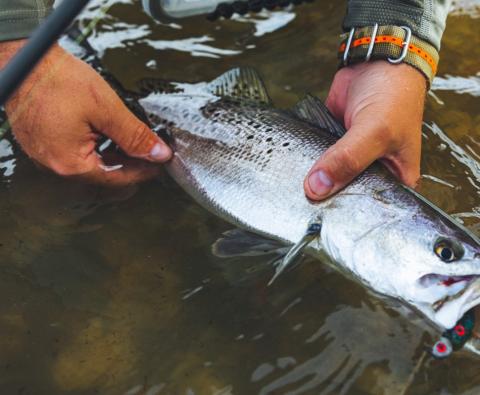Brad Mormann | Originally published in GameKeepers: Farming for Wildlife Magazine. To subscribe, click here.
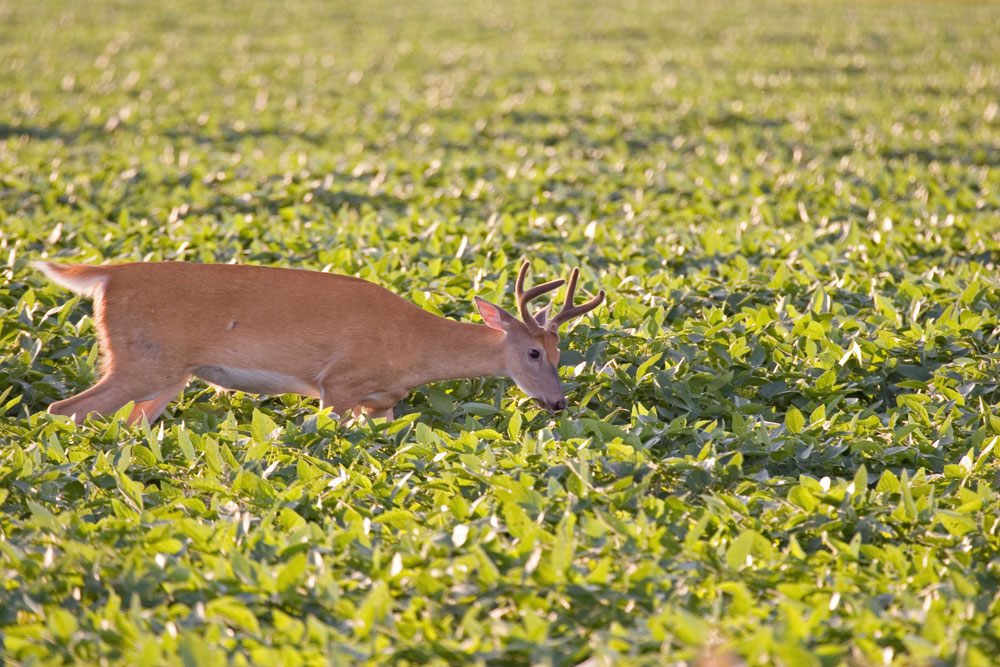
No-Till Food Plot Farming
Spending countless hours in a treestand whether with a bow or gun in hand, often leads to something much deeper than scouring the nearby scenery for a passing buck. It is a time to reflect on what I’ve done to improve my local deer herd. Have I taken the right steps to ensure every deer has the chance to reach its genetic potential? One of these steps is protecting and improving my hunting land’s soil, because “if it isn’t in the dirt, it isn’t in the deer herd.”
Agricultural technological advances like the plow have provided tremendous benefits that allowed farming production to reach new heights. It gave early farmers the ability to break through the thick sod and cut the deep roots of prairie plants throughout the country. This practice gave their preferred crops of small grains, corn and soybeans the upper-hand.
However, repeated turning also left the soil unprotected from the driving wind and rain. This resulted in the continual loss of topsoil. “Seeing is believing,” and I definitely saw the results of decades of soil erosion in a field where I was building a pond last summer. The field was in CRP, but before being enrolled in the program it had a long history of continuous row-cropping and conventional tillage (disking, plowing, etc.). During the excavation of the dam’s core trench in the valley’s bottom, the back-hoe dug over 5 feet deep through black topsoil. Then the contractor turned to the neighboring hillside to acquire clay to fill the trench. With only one pass of his dozer blade the grass and thin layer of topsoil was removed and a deep layer of clay was ready for the taking.
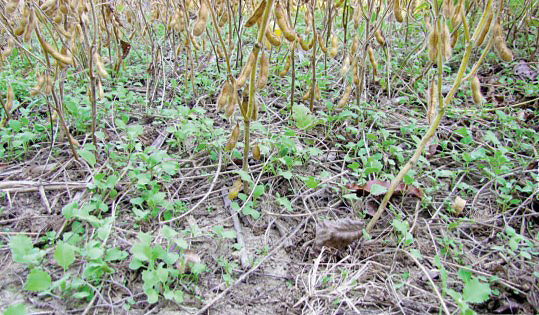
As you can see, the difference in topsoil depths was quite apparent. The grass density and height in the field similarly reflected the poorer quality hillsides versus the high quality valley. There is no doubt that over time soil erosion occurred even in the dense prairies before the plow was invented, but the years of tillage greatly sped up the process resulting in over 5 tons of topsoil being lost per acre per year.
A question to ask yourself is if you would rather have a whole farm covered in high quality soil or only the 10% of what is in the valleys? In deer terms, would you rather have deer eating a nutrient rich diet 10% of the time or all the time? So, whether you farm 500 acres of row crops or 5 acres of food plots you can make a difference. “No-till” farming is simply what it says – “no soil tilling.”
No-till systems leave plant residue (leaves and stems) on the soil surface to intercept rain drops reducing soil compaction and slowing water movement to allow for increased infiltration. It also allows root structures to remain in place to provide soil stability. These aspects lead to higher soil moisture levels and significantly less water runoff and soil erosion. Not to mention waste grains are also more easily accessible to wildlife for a much longer time.
These qualities are especially important on hunting properties because they are often located on poorer quality land to start with. I have many memories of pulling a no-till drill across the extremely thin, rocky soils in the Ozarks of southern Missouri, actually the ringing in my ears as I write this continues to remind me... Whether it was one coulter striking a rock or all 16 at once the clanging and banging never stopped.
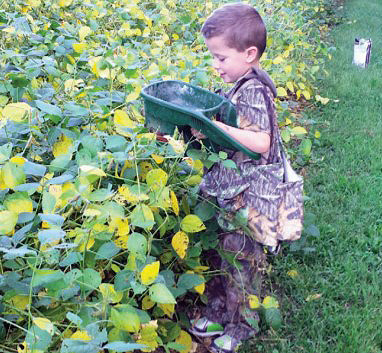
management will help to create lasting memories for you
both. Here the author’s son Luke helps to overseed a
standing soybean field. Although the portion of the food
plot he helped plant may be patchy and have areas of
“dog hair thick” brassicas, he is still learning pieces of
the no-till puzzle.
All the while being a constant reminder that minimizing soil erosion was critical to good forage production. Even states, counties and individual properties known for tremendously deep soil include areas that have naturally thin soil, or due to past management practices have little or no topsoil at all. Sure the soil is deep, but not all soil is created equal when it comes to providing quality plant growth, just as I witnessed while building a pond in the heart of Iowa where the field slopes had noticeably shorter vegetation and thinner top soil than adjacent valleys.
No-Till Drilling and Broadcast Seeding
No-till drilling and broadcast seeding are great for food plots and agricultural grain fields alike. As I mentioned, with soils being different from location to location so too can be the results of farming practices. For instance, on the extremely thin rocky soils of the Ozarks, broadcasting into standing crops didn’t work very well, while the same practice worked extremely well in other locales.
On those thin rocky soils however, a no-till drill worked great whether planting during the spring after mowing down the previous year’s crop or in the fall planting directly into heavily foraged soybeans. With a little experimentation and/or visiting with some local farmers, you too can determine what works well on your site-specific conditions. For many “hunters” interested in trying out no-till food plot production, the main issue is that they don’t own the land they hunt. There are always options and one of them in row crop country is cover crops. Luckily there are even funding sources available to plant them.
Currently the Natural Resource Conservation Service (NRCS) and other governmental and private organizations are actively promoting cover crops in farm management and in some circumstances provide cost share for the practice. Because cover crops are generally small seeded grains and brassicas they do extremely well in a no-till system and are near the top of a deer’s breakfast, lunch and dinner menu. They are also great choices because of the payback they provide the soil. As the benefits of cover crops reach more farmers, and maybe you are the one to turn them on to the benefits, the opportunity is there to make a win/win. You get a quality food source for deer and the farmer gets soil and economic benefits. Soil benefits include maintaining high quality soil throughout the property instead of just the valleys, improved soil moisture and soil structure.
Economic benefits include reduced fuel and labor costs. If these incentives are not enough to peak the landowner’s interest consider providing the seed, labor or equipment to help them. Allowing the landowner to witness the results of no-till planting and cover crops may lead them to increase their use in the future. I had just this opportunity last fall. I could tell the landowner had a conservation interest the year before when he left an acre of corn in the back corner unharvested for the deer and turkey.
The following spring he again planted that portion of the field in corn and the rest in soybeans. Seeing this interest and wanting to pursue it to the next level I asked if he would be willing to allow me to broadcast Biologic’s Maximum brassica mix in a one and a half acre area near one of my favorite treestands. After discussing what my full plan was he approved it and we then went on to talk about the benefits of no-till planting and cover crops. Before the conversation was over he was seriously considering drilling the rest of the 20 acre soybean field into a cool season grain once the soybeans were harvested.
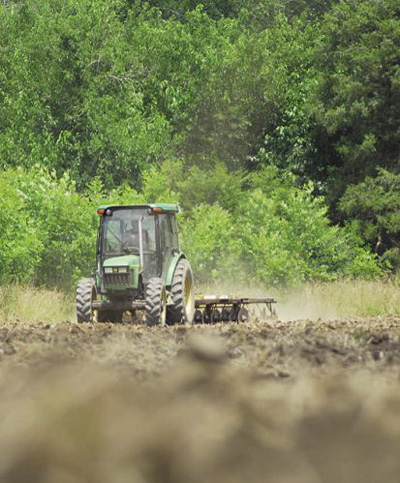
from the driving wind and rain resulting in the loss of topsoil.
As you can imagine, I was excited to get to plant my one and a half acre food plot and just giddy that I could use the entire field. By the first week of September he was interested enough in the project to call me to let me know that the soybeans were starting to turn brown. I loaded up the seed; a hand held broadcaster and my six year old son Luke to help plant the food plot. Once in the field it was apparent the lush green soybeans of mid-August were changing colors to yellow and brown. They were also taking on a more disheveled look. I went to work broadcasting the seed.
Now, I’ll be honest, the waist high soybeans did not make it easy to walk. They required me to high step through the field while gripping the broadcaster and turning the handle. It didn’t take long for me to be winded so I simply put less seed in the hopper and returned to Luke more frequently to have him refill my broadcaster and take a breather. Luke had a great time and joined in on the process by seeding the area along the edge of the plot. Let’s just say that area received really good coverage. It was all worth it as he got to help out with daddy’s food plot and I got seed on the ground.
By the fourth week of September the landowner had harvested the soybeans. The brassicas had already germinated and in near drought conditions had put on several inches of growth. The landowner went the next step and drilled the remaining portions of the field into annual rye. Within a couple of weeks a field of just soybean stubble turned into one and a half acres of brassicas and 18.5 acres of annual rye. And then there was a slight bump in the road… The landowner decided to fertilize the entire field with effluent from the nearby town’s sewer plant.
As you can imagine my heart sank as I stepped out of the truck and noticed this during the first week of October. Human waste can function as a pretty good deer repellant. Luckily I had a backup plan and a few other stands to hunt. During the interim, the brassicas and rye had extra time to put on some growth before the deer started eating them. It will all be another learning experience and great conversation with the landowner. Whether I harvested a single deer or not, I knew that fall and winter, and for years to come, the deer herd would be in as good or better shape than in years past. Because the collaborative effort stopped the use of fall tillage, minimized soil erosion and nutrient loss, provided a tremendous food source and an opportunity for the landowner to see the benefits of no-till cover crops.
Benefits of No-Till Farming
No-till systems will:
- Reduce soil erosion allowing high quality forages to grow throughout a property instead of just in the valleys.
- Improve soil structure and moisture holding capacity, increasing plant growth and productivity.
- Reduce production costs allowing more money to be spent on other deer management activities.
- Maximize forage availability for deer and other wildlife.















